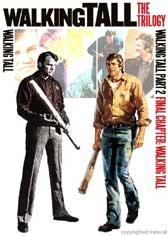 WALKING
TALL: THE TRILOGY (1973/1975/1977)
WALKING
TALL: THE TRILOGY (1973/1975/1977)Directors: Phil Karlson/Earl Bellamy/Jack Starrett
Shout! Factory
 WALKING
TALL: THE TRILOGY (1973/1975/1977)
WALKING
TALL: THE TRILOGY (1973/1975/1977)Joe Don Baker (and then Bo Svenson) walks tall and carries a big stick as legendary sheriff Buford Pusser in the three films comprising WALKING TALL: THE TRILOGY, out on DVD and Blu-Ray in three disc sets from Shout! Factory.
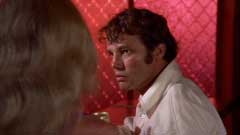
Wrestler Buford the Wild Bull (Joe Don Baker, THE LIVING DAYLIGHTS), having grown tired of the “organized dishonesty” of the wrestling circuit, moves back to his idyllic home town with his wife Pauline (Elizabeth Hartman, THE BEGUILED) and kids Mike (Leif Garrett, SKATEBOARD) and Dwana (Dawn Lyn, TV’s MY THREE SONS). His father (Noah Beery Jr., TV’s CIRCUS BOY) helps him find a house with a lot of land – and “two catfish ponds” – while his mother (Lurene Tuttle, PSYCHO) warns him to pay no mind to the changes he may notice around the town. His old football buddy Lutie McVey (Ed Call, A NIGHTMARE ON ELM STREET) shows him some of these changes, including the “shopping mall of sin” Pine Ridge Club and the Lucky Strike casino. When Buford intervenes in a crooked dice game, Lutie is murdered and Buford beaten, stabbed, and left for dead in a ravine. The local sheriff (Gene Evans, SHOCK CORRIDOR) is not only ineffectual, he’s clearly “learned to crawl” and is on the take; so Buford has to take the law into his own hands (and a handy 2x4 from his father’s lumber mill). Buford is arrested and tried before a corrupt judge (Douglas Fowley, BLACK OAK CONSPIRACY) and is surprisingly exonerated by the jury. When the sheriff tires to run Buford down, he crashes and Buford rescues deputy Grady Coker (Bruce Glover, DIAMONDS ARE FOREVER) from the wreck. Grady refuses to take a bribe and testify against Buford, who wins the election for sheriff. With the help of Grady and deputized friend Obra (Felton Perry, MAGNUM FORCE), he starts cleaning up his home town; however, various ne'er-do-wells including whorehouse owner Callie Hacker (Rosemary Murphy, TO KILL A MOCKINGBIRD) and the Stateline Mob (represented by John Witter [Logan Ramsey], whose character would appear in all three films) – as they are wont to do – decide to retaliate, endangering not only Buford, but also his wife and kids.
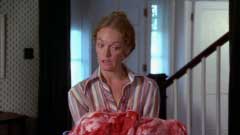 Despite
being produced by Bing Crosby Productions, WALKING TALL as a biopic is aimed
squarely at the exploitation market and the vigilante sub-genre (it was appropriately
distributed by Cinerama Releasing Corporation). “Suggested by” the
life of Pusser – who died in 1974 in a car accident after having agreed
to appear as himself in the proposed sequel – this is one of those cases
where the real story (as far as one can piece it together) is much more interesting;
however, it would also make a less-than-tidy and morally ambiguous narrative.
WALKING TALL plays it simplistically: incorruptible Buford wants to settle down
with his family, finds his home town corrupted by the mob, is forced to take
the law into his own hands when everyone else is either corrupt or scared, and
can thus beat and batter his way through any one-dimensional unsavory elements
that step into his path (he tells his wife “Nuthin’ wrong with a
gun if it’s in the right hands”). Fortunately, Baker brings life
to what could have been an intolerable character (he is especially moving during
the climax). Hartman is even better as Pusser’s wife. It would be impossible
to discuss the sequels to the film without revealing a gigantic spoiler from
the first film’s ending (although I’m guessing that even many who
have not seen the film know what happens to Buford’s wife); however, the
film milks everything it can out of the supposedly shocking plot turn. Glover
gets a good character arc and acquits himself well. Real life siblings Lyn and
Garrett would play the same roles in the film’s two sequels (they also
appeared together with their mother Carolyn Stellar in DEVIL TIMES FIVE, who
cameos in the second WALKING TALL film). The rest of the cast is good, but hampered
by the shallow scripting (Grandma Pusser isn’t exaggerating when she says
that “everything calls for a drink” according to her husband). Despite
some crowd-pleasing graphic violence (with some painful-looking blows from Pusser's
hickory stick), the supporting cast (which includes Kenneth Tobey [THE THING
FROM ANOTHER WORLD], Pepper Martin [SUPERMAN II], and Richard X. Slattery [THE
BOSTON STRANGLER]), Walter Scharf’s score, and TV cameraman Jack A. Marta’s
slick photography generally goes against the grindhouse grit needed to make
this film more enjoyable. Johnny Mathis' theme song is another misstep.
Despite
being produced by Bing Crosby Productions, WALKING TALL as a biopic is aimed
squarely at the exploitation market and the vigilante sub-genre (it was appropriately
distributed by Cinerama Releasing Corporation). “Suggested by” the
life of Pusser – who died in 1974 in a car accident after having agreed
to appear as himself in the proposed sequel – this is one of those cases
where the real story (as far as one can piece it together) is much more interesting;
however, it would also make a less-than-tidy and morally ambiguous narrative.
WALKING TALL plays it simplistically: incorruptible Buford wants to settle down
with his family, finds his home town corrupted by the mob, is forced to take
the law into his own hands when everyone else is either corrupt or scared, and
can thus beat and batter his way through any one-dimensional unsavory elements
that step into his path (he tells his wife “Nuthin’ wrong with a
gun if it’s in the right hands”). Fortunately, Baker brings life
to what could have been an intolerable character (he is especially moving during
the climax). Hartman is even better as Pusser’s wife. It would be impossible
to discuss the sequels to the film without revealing a gigantic spoiler from
the first film’s ending (although I’m guessing that even many who
have not seen the film know what happens to Buford’s wife); however, the
film milks everything it can out of the supposedly shocking plot turn. Glover
gets a good character arc and acquits himself well. Real life siblings Lyn and
Garrett would play the same roles in the film’s two sequels (they also
appeared together with their mother Carolyn Stellar in DEVIL TIMES FIVE, who
cameos in the second WALKING TALL film). The rest of the cast is good, but hampered
by the shallow scripting (Grandma Pusser isn’t exaggerating when she says
that “everything calls for a drink” according to her husband). Despite
some crowd-pleasing graphic violence (with some painful-looking blows from Pusser's
hickory stick), the supporting cast (which includes Kenneth Tobey [THE THING
FROM ANOTHER WORLD], Pepper Martin [SUPERMAN II], and Richard X. Slattery [THE
BOSTON STRANGLER]), Walter Scharf’s score, and TV cameraman Jack A. Marta’s
slick photography generally goes against the grindhouse grit needed to make
this film more enjoyable. Johnny Mathis' theme song is another misstep.
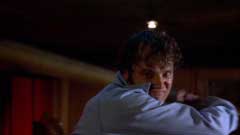
WALKING TALL was the penultimate film for director Phil Karlson (who had previously directed BEN for Bing Crosby Productions); his last film was FRAMED (which also starred Baker and was written and produced by WALKING TALL scripter/producer Mort Briskin) for Paramount. Bing Crosby Productions was founded in the mid-forties to back a number of Crosby films (including the ROAD TO… series with Bob Hope). Throughout the entirety of the sixties, however, the company was mainly engaged in producing THE BING CROSBY SHOW, BEN CASEY, and HOGAN’S HEROES for TV. The company resumed film production in 1971 with mainly genre product including WILLARD, BEN, the black comedy ARNOLD, TERROR IN THE WAX MUSEUM, and THE REINCARNATION OF PETER PROUD. The company also produced the two sequels (which were distributed by American International) starring Bo Svenson. The film also inspired a TV movie, a TV series (again with Svenson), as well as a lackluster – and even less recognizable – MGM remake with Dwayne “The Rock” Johnson (which itself inspired two direct-to-DVD sequels with Kevin Sorbo).
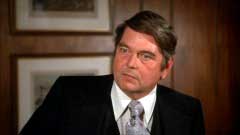 WALKING
TALL was first released on DVD in 2003 by Rhino Video with its two sequels,
reportedly using older tape masters for their transfers. In 2007, Paramount
released a much-improved anamorphic widescreen barebones DVD which is now out
of print (and pretty expensive). Shout’s disc of WALKING TALL opens with
a Viacom-era Paramount logo (too bad Shout! didn’t insert a vintage logo)
and features an attractive dual-layer, progressive, anamorphic 1.78:1 widescreen
transfer. Since the DVD insert only lists a telecine colorist for the sequels,
it is likely that Shout has used Paramount’s existing master for the first
film (which may also explain the Viacom logo). The Dolby Digital 2.0 mono track
is clean and vibrant from the very first notes of the music score by Walter
Scharf (who was nominated for an Academy Award for the theme song to BEN). The
only extras are two 30-second TV spots and a step-through photo gallery.
WALKING
TALL was first released on DVD in 2003 by Rhino Video with its two sequels,
reportedly using older tape masters for their transfers. In 2007, Paramount
released a much-improved anamorphic widescreen barebones DVD which is now out
of print (and pretty expensive). Shout’s disc of WALKING TALL opens with
a Viacom-era Paramount logo (too bad Shout! didn’t insert a vintage logo)
and features an attractive dual-layer, progressive, anamorphic 1.78:1 widescreen
transfer. Since the DVD insert only lists a telecine colorist for the sequels,
it is likely that Shout has used Paramount’s existing master for the first
film (which may also explain the Viacom logo). The Dolby Digital 2.0 mono track
is clean and vibrant from the very first notes of the music score by Walter
Scharf (who was nominated for an Academy Award for the theme song to BEN). The
only extras are two 30-second TV spots and a step-through photo gallery.
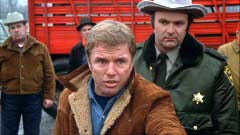
The opening of WALKING TALL: PART 2 finds Buford recovering from the events of the first film (having had half his face shot off, he recovers without any scars and now looks like Bo Svenson, CHOKE CANYON). The townspeople are apprehensive about the possibility of Buford running for re-election once he recovers; however, his parents (Beery and Tuttle again) and his deputies Grady (Glover again) and Obra (now Robert DoQui, COFFY) know that Buford will not rest until he tracks down everyone involved in the ambush that killed his wife. John Witter (Logan Ramsey again) instructs backwoods bootlegger Pinky Dobson (Luke Askew, EASY RIDER) and his partner Ray Henry (John Davis Chandler, PHANTASM III) to get rid of Pusser when he comes out of hiding, and to make it look like an accident. Dobson gets the idea to hire racecar driver Stud Pardee (Richard Jaeckel, THE DARK) – who has a habit of explosively running competitors’ cars off the track – to sabotage Buford’s car. Meanwhile, Buford returns to work, and is determined to continue defending the public rather than using his office to get vengeance; although, Grady and Obra are both afraid that the sheriff will be the victim of another ambush. Buford himself is a bit skittish, especially when he learns that one of his ambushers was a hired killer from Boston that the FBI has been trailing. Buford and his men bust up several stills in the backwoods with a bent towards discovering the main supplier and distributor (presumably the person who put the hit out on Buford that killed his wife). Witter doesn’t trust Dobson’s abilities, so he hires Margianne (Angel Thomkins, THE BEES) to pose as a Southern Belle of a historian and seduce Buford into a “can’t miss situation.” Ray Henry thinks that Dobson and Witter are making things too complicated, and gets his hands on a machine gun.
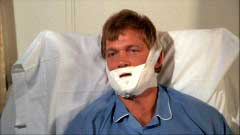 Although
produced by Bing Crosby Productions, WALKING TALL: PART 2 was distributed this
time around by American International; and it actually feels more like an AIP
exploitation film. Svenson does well in the lead, although the character goes
through a lesser range of emotions in this entry (which takes place a year after
the events of the first film). Although the film moves at a faster pace than
the original, at 109 minutes, it’s still a bit overlong with some brief
but unnecessary scenes and some abrupt cuts seem like these bits were curtailed
for pacing. Although Witter is shown emphatically telling someone on the phone
to spend however much is needed to buy the election, the next scene shows Buford
returning to his job having effortlessly won the election (actually the election
is a major plot point of the third installment, but that was two years away
and this film’s ending gives the impression that a sequel is not forthcoming
[suggesting the possibility that the third film might be the entire second half
of a treatment/outline found unwieldy when scripted). The violence is reduced
in this film, emphasizing auto and boat stunts over body blows (Buford carries
his stick but only gets to use it on Stud Pardee’s prized race car) and
bullet hits (although there are a few during the finale). Since this is a 1970s
PG film, there's still some nudity and profanity, though. Action scenes are
kind of limp for most of the film. Stills are busted by Buford and his men with
minimal chasing, gunplay, or fighting. The last third, however, packs a number
of car chases, boat chases, and a standoff between Buford and the last of his
would-be assassins; and this section is considerably more entertaining. The
dramatic scenes suffer too. Garrett and Lyn are also back as Buford’s
children, and he hugs them whenever they mention their mother, but that’s
really all they are there for. Only one brief scene is devoted to the tension
between Buford and his father as his investigation unmasks the criminal activities
of some of the town’s respected men, and Buford only sheds tears for a
man who died in his place when yet another of his cars is sabotaged.
Although
produced by Bing Crosby Productions, WALKING TALL: PART 2 was distributed this
time around by American International; and it actually feels more like an AIP
exploitation film. Svenson does well in the lead, although the character goes
through a lesser range of emotions in this entry (which takes place a year after
the events of the first film). Although the film moves at a faster pace than
the original, at 109 minutes, it’s still a bit overlong with some brief
but unnecessary scenes and some abrupt cuts seem like these bits were curtailed
for pacing. Although Witter is shown emphatically telling someone on the phone
to spend however much is needed to buy the election, the next scene shows Buford
returning to his job having effortlessly won the election (actually the election
is a major plot point of the third installment, but that was two years away
and this film’s ending gives the impression that a sequel is not forthcoming
[suggesting the possibility that the third film might be the entire second half
of a treatment/outline found unwieldy when scripted). The violence is reduced
in this film, emphasizing auto and boat stunts over body blows (Buford carries
his stick but only gets to use it on Stud Pardee’s prized race car) and
bullet hits (although there are a few during the finale). Since this is a 1970s
PG film, there's still some nudity and profanity, though. Action scenes are
kind of limp for most of the film. Stills are busted by Buford and his men with
minimal chasing, gunplay, or fighting. The last third, however, packs a number
of car chases, boat chases, and a standoff between Buford and the last of his
would-be assassins; and this section is considerably more entertaining. The
dramatic scenes suffer too. Garrett and Lyn are also back as Buford’s
children, and he hugs them whenever they mention their mother, but that’s
really all they are there for. Only one brief scene is devoted to the tension
between Buford and his father as his investigation unmasks the criminal activities
of some of the town’s respected men, and Buford only sheds tears for a
man who died in his place when yet another of his cars is sabotaged.

Aside from Askew (who died last month), Glover, and Beery, supporting performances are more than a little broad. Ramsey goes way over the top, and Thomkins goes so sickly sweet with her Southern accent that it is hard to believe anyone would be taken in. DoQui, on the other hand, is a bit too low key compared to Perry in the first film. Brooke Mills (THE BIG DOLL HOUSE), as Dobson’s girlfriend Ruby Ann, appears only briefly early in the film, but has more screen time during the climax and impresses. Libby Boone (THE BOOST) turns in an understated performance as a receptionist carrying a torch for Buford. This subplot doesn’t get much screen time, but she’s also in the third film. Lyn and Garrett’s mother Carolyn Stellar has a cameo a nurse. Although shot after the real-life death of Pusser in an auto wreck (which some – including Pusser’s daughter – still believe was not an accident), the production was mounted with the expectation that Pusser himself would play the lead; whether because of this, or because of his death, the film opens with a signed disclaimer by screenwriter Howard Kreitsek (THE ILLUSTRATED MAN) – who also penned the third film – that the events are true, but names have been changed. Carl Pusser (Buford’s father) serves as technical consultant on this and the third film. Although he directed only ten features in his fifty-odd years as a filmmaker, director Earl Bellamy had been an assistant director in the 1940s and 1950s on roughly 50 films (including RETURN OF THE VAMPIRE, FROM HERE TO ETERNITY, and A STAR IS BORN) and an extremely prolific career from the fifties to the early 1990s as a television director from westerns (WAGON TRAIN, THE LONE RANGER, TALES OF WELLS FARGO) to sitcoms (BACHELOR FATHER, LEAVE IT TO BEAVER, GET SMART) to detective/cop shows (I SPY, HART TO HART, STARSKY AND HUTCH) and so on.
 Shout’s
new anamorphic, progressive HD-mastered 1.78:1 widescreen transfer opens with
a few seconds of a curtailed American International logo before cutting to the
end of Cinerama Releasing (we don’t see the familiar animation). Image
quality is good throughout. I didn’t have my eye on the screen the entire
time, but I didn’t notice any damage. Scharf’s theme music sounds
duller here than it did on the Paramount transfer of the first film (the sequels
were also licensed from Paramount, but they did not prepare masters for either
of them), but he audio is mostly clean save for a momentary bit of damage during
the funeral scene late in the film.
Shout’s
new anamorphic, progressive HD-mastered 1.78:1 widescreen transfer opens with
a few seconds of a curtailed American International logo before cutting to the
end of Cinerama Releasing (we don’t see the familiar animation). Image
quality is good throughout. I didn’t have my eye on the screen the entire
time, but I didn’t notice any damage. Scharf’s theme music sounds
duller here than it did on the Paramount transfer of the first film (the sequels
were also licensed from Paramount, but they did not prepare masters for either
of them), but he audio is mostly clean save for a momentary bit of damage during
the funeral scene late in the film.

Disc 2 features the meatiest extra in the form of an all-new documentary “Walking Tall: The Buford Pusser Story” (29:18) featuring Pusser’s daughter Dwana, his granddaughter Madison Garrison, historian Steve Sweat (who mentions that one of the first stills Pusser busted belonged to his brother), Jack Coffman (Pusser’s friend), as well as Madison County Lt. Jerry Elstrom and Sheriff David Woolfork, and Renee Moss (granddaughter of Deputy Jim Moffett, the character on which Glover’s Grady Coker is based), as well as actors Bruce Glover, Leif Garrett, Dawn Lyn, and Joe Don Baker (who is only heard over scenes of his younger self). Dwana Pusser says that the producers blew the “big stick” aspect out of proportion (Pusser didn’t have a carved hickory stick, but he would sometimes grab a tree branch or a piece of scrap wood before going into a situation). Svenson is noticeably absent from the documentary. Lyn says that Baker (who was a personal friend of Pusser before the first film) resembled Pusser more in the emotional aspect, while Svenson better matched him physically. Glover reveals that Pusser for a screen test to appear in the second film (with Baker’s encouragement, Pusser even stayed with Baker while he was in Los Angeles). The cast – especially Glover – fondly remember Elizabeth Hartman (who committed suicide in 1987), Noah Berry, and Lauren Tuttle (Dwana Pusser tells a funny anecdote about her grandmother’s reaction to seeing the actress who would play her on film). A spacey Garrett seems rather disinterested and has nothing to say of particular value. Sheriff Woolcock agrees with Pusser’s family that the circumstances around Pusser’s death are suspicious. It’s an interesting collection of comments, but the focus is unevenly divided between Pusser’s memory and the film anecdotes. Three TV spots (two 30-second and one 10-second), a theatrical trailer (1:54), and a photo gallery round out the extras on disc 2.
 Svenson
is back in FINAL CHAPTER: WALKING TALL, but the credits emphasize that Grandpa
Pusser is now played by Forrest Tucker (although Beery worked well into the
1980s in film and television before his death in 1994). The third film seems
to begin right after the events of the second film – it’s still
been only a year since Pauline’s death – but both of Buford’s
kids (Dawn Lyn and Leif Garrett again) have had significant growth spurts, and
new social interests that will keep them busy throughout the film until the
required emotional family moments. Buford wants to go after Witter (Logan Ramsey
again), but he’s hiding out in New York and the Tennessee Bureau of Investigation
have no proof that Witter ordered the assassination attempt, and they want their
investigation of Witter to be handled objectively. Meanwhile, in New York, The
Boss (Morgan Woodward, COOL HAND LUKE) has had enough of Witter’s mistakes
and has decided to reallocate some of Witter’s interests to another party.
Despite this seeming to be a done deal, Witter is making calls to get any kind
of dirt on Buford in order to keep him from winning re-election. He’s
not the only one who has it out for Buford since “bleeding heart liberal”
lawyer Martin French (Taylor Lacher, who had previously appeared in DEVIL TIMES
FIVE with Lyn and Garrett) thinks that McNeery County no longer needs a rule-bending
sheriff. As a public defender, he takes umbrage to the corporal punishment Buford
meted out to bootlegger O.Q. Teal (Clay Tanner, of director Jack Starrett’s
RACE WITH THE DEVIL) after he witnessed him whipping son Robbie (David Adams,
SOME KIND OF HERO). French also declares a civil rights violation when Buford
handcuffs the three teenagers (two poor and one black) who stole his car and
forces them to rake up the courthouse lawn. Buford’s attorney friend Lloyd
Tatum (Sandy McPeak, THE ONION FIELD) calls a town meeting to counter the campaign
French has built up against Buford for re-election. Buford foregoes putting
in an appearance at the meeting when Harden County Sheriff Clegg (Lecile Harris)
calls him out to view the body of murdered Luan Paxton (Margaret Blye, THE ENTITY)
- played in the first film by Brenda Benet (TRACK OF THUNDER) - an ex-hooker
turned realtor who had been an informant to Buford years before. Earlier, Clegg
had asked Buford to bust up a club called The 3 Deuces, which existed in a bureaucratic
no-mans-land right in between McNeery and Harden and owned by one “John
Smith.” Buford busts up (and dynamites) the club; however, his efforts
fail to win him re-election and he is soon working as a mechanic while the townspeople
are realizing just how much they needed him and the new sheriff (R.D. Smith)
proves ineffectual. With Pusser no longer sheriff, Witter returns to town; however,
Buford is more concerned with feeding his family (his parents’ savings
have also taken a hit with rising taxes and carrying him and their grandchildren).
When a Los Angeles movie producer (John Malloy, CANNERY ROW) sees Buford’s
story on the news and approaches him to make a movie about it, the success not
only gets his family out of the hole but also sets Witter on a vendetta unsanctioned
by The Boss.
Svenson
is back in FINAL CHAPTER: WALKING TALL, but the credits emphasize that Grandpa
Pusser is now played by Forrest Tucker (although Beery worked well into the
1980s in film and television before his death in 1994). The third film seems
to begin right after the events of the second film – it’s still
been only a year since Pauline’s death – but both of Buford’s
kids (Dawn Lyn and Leif Garrett again) have had significant growth spurts, and
new social interests that will keep them busy throughout the film until the
required emotional family moments. Buford wants to go after Witter (Logan Ramsey
again), but he’s hiding out in New York and the Tennessee Bureau of Investigation
have no proof that Witter ordered the assassination attempt, and they want their
investigation of Witter to be handled objectively. Meanwhile, in New York, The
Boss (Morgan Woodward, COOL HAND LUKE) has had enough of Witter’s mistakes
and has decided to reallocate some of Witter’s interests to another party.
Despite this seeming to be a done deal, Witter is making calls to get any kind
of dirt on Buford in order to keep him from winning re-election. He’s
not the only one who has it out for Buford since “bleeding heart liberal”
lawyer Martin French (Taylor Lacher, who had previously appeared in DEVIL TIMES
FIVE with Lyn and Garrett) thinks that McNeery County no longer needs a rule-bending
sheriff. As a public defender, he takes umbrage to the corporal punishment Buford
meted out to bootlegger O.Q. Teal (Clay Tanner, of director Jack Starrett’s
RACE WITH THE DEVIL) after he witnessed him whipping son Robbie (David Adams,
SOME KIND OF HERO). French also declares a civil rights violation when Buford
handcuffs the three teenagers (two poor and one black) who stole his car and
forces them to rake up the courthouse lawn. Buford’s attorney friend Lloyd
Tatum (Sandy McPeak, THE ONION FIELD) calls a town meeting to counter the campaign
French has built up against Buford for re-election. Buford foregoes putting
in an appearance at the meeting when Harden County Sheriff Clegg (Lecile Harris)
calls him out to view the body of murdered Luan Paxton (Margaret Blye, THE ENTITY)
- played in the first film by Brenda Benet (TRACK OF THUNDER) - an ex-hooker
turned realtor who had been an informant to Buford years before. Earlier, Clegg
had asked Buford to bust up a club called The 3 Deuces, which existed in a bureaucratic
no-mans-land right in between McNeery and Harden and owned by one “John
Smith.” Buford busts up (and dynamites) the club; however, his efforts
fail to win him re-election and he is soon working as a mechanic while the townspeople
are realizing just how much they needed him and the new sheriff (R.D. Smith)
proves ineffectual. With Pusser no longer sheriff, Witter returns to town; however,
Buford is more concerned with feeding his family (his parents’ savings
have also taken a hit with rising taxes and carrying him and their grandchildren).
When a Los Angeles movie producer (John Malloy, CANNERY ROW) sees Buford’s
story on the news and approaches him to make a movie about it, the success not
only gets his family out of the hole but also sets Witter on a vendetta unsanctioned
by The Boss.

The graphic violence is back (as is the R-rating).Buford gets to use his stick on several miscreants (most satisfyingly in the 3 Deuces scene), Luan gets tortured for informing, Buford takes some bloody bullet hits to the face during the opening flashback to the ambush, and gets to dynamite some stills and whorehouses. The car chases are also better directed and photographed this time around. Director Starrett already had a respectable exploitation resume with CLEOPATRA JONES, RUN ANGEL RUN, THE STRANGE VENGEANCE OF ROSALIE, SLAUGHTER, RACE WITH THE DEVIL, A SMALL TOWN IN TEXAS, and CRY BLOOD, APACHE (a western which featured an early uncredited appearance by Dawn Lyn and a larger part for her mother Carolyn Stellar). Svenson gets more to work with here emotionally (as does Lyn later in the film). The problem with both sequels is that – despite a flashback of Pauline’s death with Baker replaced by Svenson – and a scene at the movie screening where Buford sees the cinematic off-screen recreation of the ambush, both films are distanced by time and by casting from the outrages suffered by Joe Don Baker’s Buford in the first film; however much both sequels may reference them (on the other hand, the two sequels are more enjoyable as exploitation films). Even watching all three films back-to-back does not give a sense of emotional continuity for the viewer. Despite several of the characters’ dislike of “bleeding heart liberal” French, the film portrays him as a man with genuine convictions rather than as another villain out to ruin Buford. McPeak is also good as he transitions from Buford’s colleague to his concerned friend, and the recasting of Grandpa Pusser with Tucker even suits the more serious situation in which he finds himself here. Boone is back to add more to the unrequited relationship with Buford, although she looks a little chubbier here (and this is not helped by having several of her scenes in this film involving talking about or consuming food). Glover is given little to do or say this time around. Although the movie deal did get the Pusser’s out of their financial hole, the notion that the film’s producers (all three films were produced by the same company) “saved” them leaves a bad taste. Buford does have some apprehension about the film’s need to recreate Pauline’s death, and he is disturbed by the scene at the film’s screening (we only hear the soundtrack); but, by this time, the 112 minute is racing too fast towards the ending we all know is coming to concern itself too much with any real exploration of Buford’s conflicting emotions (or those of his family) about his fame. Buford’s brother John Howard Pusser is credited alongside his father as a technical consultant.
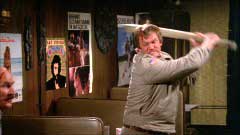 Like
PART II, Shout’s dual-layer, progressive, anamorphic 1.78:1 widescreen
transfer is very clean-looking (save a few quickly glimpsed bits of damage).
On the whole, it looks better, but that may have more to do with it being the
more recent film (and probably higher budgeted). The Dolby Digital mono track
is clean and in good condition. Besides the usual trailer (1:22), disc 3 also
features a vintage behind-the-scenes featurette “Buford Pusser: The Man
and the Myth” (8:40). It features the participation of Lloyd Tatum (a
judge at the time of filming), Mayor Leonard Blanton, journalist Carol Laney
(who wrote THE BUFORD PUSSER PROJECT, a lengthy oral history interview with
Pusser’s mother), producer Charles Pratt, director Jack Starrett, and
Svenson. Although it purports to focus on Pusser himself with comments from
the aforementioned people who knew him, it really is a promotional piece for
the film. The set also includes a small booklet featuring posters and lobby
cards from the three films, as well as synopses, credits, and listings of each
disc’s extras. Disc credits are on the back page of the booklet. All three
discs are coded for Region 1 playback only. (Eric
Cotenas)
Like
PART II, Shout’s dual-layer, progressive, anamorphic 1.78:1 widescreen
transfer is very clean-looking (save a few quickly glimpsed bits of damage).
On the whole, it looks better, but that may have more to do with it being the
more recent film (and probably higher budgeted). The Dolby Digital mono track
is clean and in good condition. Besides the usual trailer (1:22), disc 3 also
features a vintage behind-the-scenes featurette “Buford Pusser: The Man
and the Myth” (8:40). It features the participation of Lloyd Tatum (a
judge at the time of filming), Mayor Leonard Blanton, journalist Carol Laney
(who wrote THE BUFORD PUSSER PROJECT, a lengthy oral history interview with
Pusser’s mother), producer Charles Pratt, director Jack Starrett, and
Svenson. Although it purports to focus on Pusser himself with comments from
the aforementioned people who knew him, it really is a promotional piece for
the film. The set also includes a small booklet featuring posters and lobby
cards from the three films, as well as synopses, credits, and listings of each
disc’s extras. Disc credits are on the back page of the booklet. All three
discs are coded for Region 1 playback only. (Eric
Cotenas)